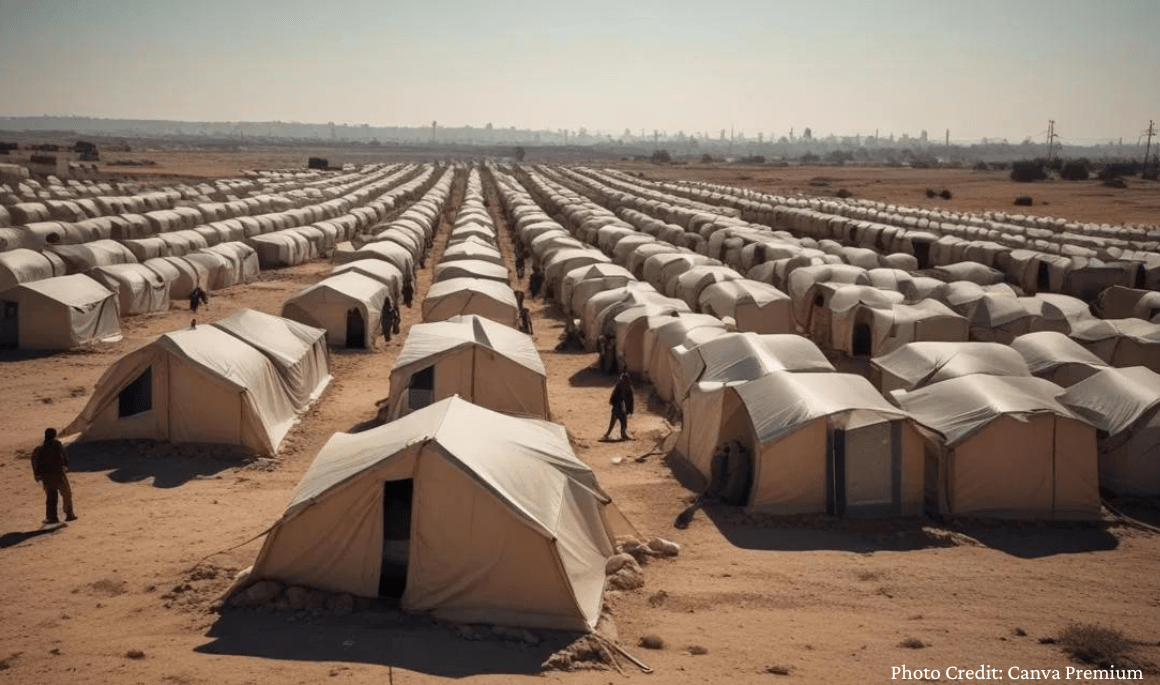- Norwich Blogs
- Blogs
- The Al Hol, Roj Camps and Syrian Detention Complex: Cruel and Dangerous Foreign Policy
The Al Hol, Roj Camps and Syrian Detention Complex: Cruel and Dangerous Foreign Policy
By Dr. Deborah Harrold
Disclaimer: These opinion pieces represent the authors’ personal views, and do not necessarily reflect the official policies or positions of Norwich University or PAWC.

While Al Hol and Roj camps in Syria have received episodic attention in mainstream media, they have been the focus of more sustained examination and reporting, with recent postings of significant research findings in the online forum, Just Security.org, and long-form journalism in The New Yorker.[i] These facilities were used to absorb the population fleeing from territory held by the Islamic State in Iraq and Syria (ISIS), as ISIS was damaged and largely destroyed through airstrikes and other military efforts. This population includes family members of ISIS fighters. The refugee population in these camps swelled in population to over 70,000 and has now been reduced to around 50,000. In addition, over 25 detention facilities housing terror suspects and with no humanitarian claims continue to receive boys, adolescents, especially foreign national boys, as they grow up in the camps. With recategorization and transfer they are interpellated as terror subjects, with beatings, interrogation, and sexualized mistreatment. Deaths from disease, from beatings and other forms of ill treatment and torture, and from assassinations occur regularly. These facilities are terrible places and reflect terrible foreign policy practices.
As a scholar of the Middle East and North Africa, I have generally lost the ability to be surprised and I am certainly resistant to shock over the treatment of people in prison facilities. I learned about Abu Ghraib while teaching a freshman class on the Middle East in North Africa; the class was reading Assia Djebar’s Fantasia: An Algerian Cavalcade. We all learned about Abu Ghraib in the media, as we read Djebar’s account of a French officer’s surprise that Algerian prisoners were begging not to be sent to a French prison camp that the officer had not heard about. Before the media revelations of Abu Ghraib, a student had spoken to me about it as a terrible rumor, and I did not think it could be true. Of course, it was.
And decades after the chaos and cruelty coming out of the US invasion of Iraq, here we are led to new social and military formations that resisted that invasion with creative and deadly mobilizations. Al-Qaeda, Shia militias, and eventually ISIS, moved into or were formed in successive chaotic conditions. The demobilization of the Iraqi military and intelligence -- a decision that gave gooseflesh to historians of the region -- released a vast group of highly trained Iraqi nationalists and expanded the possibilities of Islamist mobilization. Subsequent practices, such as de-Baathification, US training of death squads, and massive destruction of urban areas, created extensive social dislocation, insecurity, created new forms of anti-American opposition. Abu Ghraib and Delta camp, with their policies of torture, and other sites and practices of torture and planned and unplanned cruelty, consolidated the US role in the region. With the Arab uprisings of 2011 and the expanding importance of ISIS, US policy struggled to identify and respond to challenges and threats.
Incarceration of indefinite duration, building on the legacies of US security policy after 9/11 and the creative legal innovation of Guantanamo, came to be seen as a reasonable policy. While Guantanamo focused on men, the larger refugee crisis with the destruction of the Islamic State produced a population of women and children as well as men. And with such a group now incarcerated, in detention, under whatever euphemism has been crafted at the moment, we now have a population incarcerated. There is no need to use terms like community; this is a heterogenous group including Syrian and Iraqi nationals as well as those who came from Europe, the U.S., and elsewhere, from Muslim families or not, those committed to ISIS, those taken by ISIS, those fleeing ISIS… and every point in between.
In addition to all the suffering created by crowding, inadequate medical care, and food shortages, and the psychological pressure of no pathway forward, residents of Al-Hol are subject to ISIS rule from, apparently, a largely Western population of committed ISIS actors who monitor, intimidate and assassinate others.[ii] Their countries of origin have not cooperated well in removing individuals from this group and repatriating them; they remain an ISIS fragment continuing to operate and cause suffering and death, making orphans and raising children. They are legitimating themselves as the carriers of ISIS, extending ISIS rule into this captive population and habituating themselves to sustained forms of power in a difficult context.
Back to the children. Growing up in prison, growing up under a new intense ISIS rule, or graduating from this to the male camp where boys become men by category and are subject to new regimes of interrogation and punishment – these young people inherit the legacy of American cruelty.
We hear about an increased pace of repatriation. That’s certainly desirable and necessary, but it is such a national solution when some of the tragedies include people without documents, and children whose documents have been destroyed in the process of war. Some of these children are orphans, born into the destruction of their homes and social connections, and those caring for them have no documentation to hold them. Between repatriation and security concerns, these children have no place; with no documents or parents, they cannot be repatriated, and it is impossible for them to be a security concern in any meaningful sense of the term. Their situation is already tragic and bleak; their future is no less so.
I have not discussed the titular governors of these camps, the Syrian Democratic Forces composed of Kurdish-led militias. The United States organized and set the parameters for these camps, organized funding, made them possible, and continues to fly the flag beyond their limits, on uniforms, vehicles, funding, interrogation, and planning. In the name of security concerns, enormous trauma is inflicted on children, and the ISIS fragment continues to terrorize. This is how people are broken, and this is how enemies are created. Whatever legal fictions or contractual evasions have been developed to create and sustain these camps, the mistreatment of the adults, children, and adolescents in al-Hol, Roj, and associated detention camps is a major crisis for which the United States bears both responsibility and shame.
Dr. Deborah Harrold is a Senior Lecturer at the University of Pennsylvania in the College of Liberal and Professional Studies and Department of Political Science. A political scientist in comparative politics and the study of the Middle East and North Africa, she has specialized in the study of modern Algeria, with interests in the political economy and how war changes politics and society. She has published on economic discourse in Algeria, the culture of political economy issues, and what the Arab Spring contributed to our understanding of women’s issues in the region.
[i] Lauren Aarons, Janine Moma, and Nicolette Waldman, “Deaths, torture, and arbitrary detention in the wake of the Islamic State in Syria: The US Responsibility to Act,” Just Security.org, May 30, 2024. Accessed July 14, 2024.
https://www.justsecurity.org/96221/syria-after-isis-deaths-torture-us-responsibility/
Stephen Weine and Eric Rosand, “Extended detention compounds trauma for thousands of child victems of terrorism in Syria camps. Just Security.org, November 1, 2023. Accessed July 14, 2024.
Anand Gopal, “The Open-Air prison for ISIS supporters – and victims,” The New Yorker, March 11, 2024. Accessed July 14, 2024.
https://www.newyorker.com/magazine/2024/03/18/the-open-air-prison-for-isis-supporters-and-victims
[ii] Anand Gopal, “The Open-Air prison for ISIS supporters – and victims,” The New Yorker, March 11, 2024. Accessed July 14, 2024.
https://www.newyorker.com/magazine/2024/03/18/the-open-air-prison-for-isis-supporters-and-victims
And, Jo Becker and Letta Taylor, “Revictimizing the victims: Children unlawfully detained in northeast Syria,” Human Rights Watch, January 27, 2023. Accessed July 21, 2024.
Also published in Global Justice Journal, Queens Law, nd



